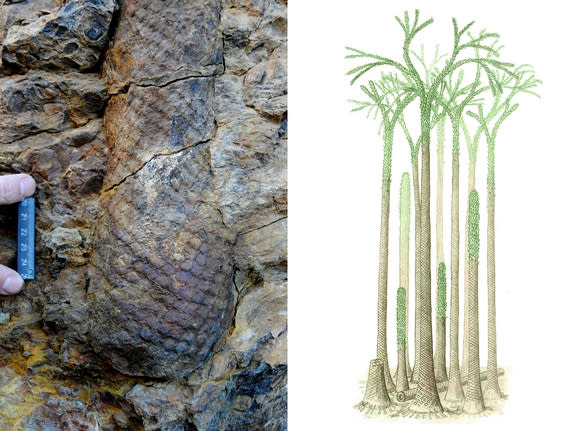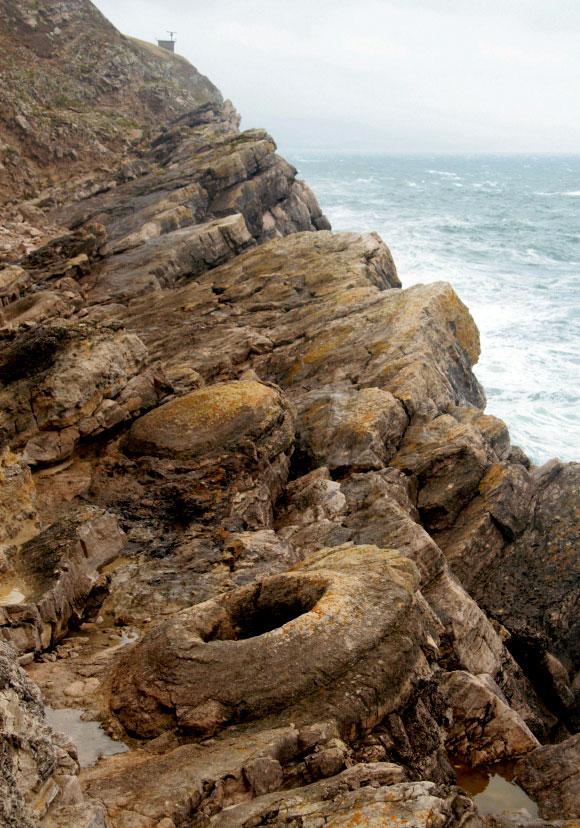
A tropical forest densely packed with 12-foot-tall trees with flared trunks and curved branches of needle leaves Dr. Seuss would have felt right at home covered an area near the equator some 380 million years ago. Scientists spotted the fossilized stumps a long way from this location in Arctic Norway.
Not only did the researchers date the forest as one of Earth's oldest, but they also suggest it may have contributed to a dramatic drop in atmospheric carbon dioxide levels traced to that time in our planet's distant past.
During the Devonian period (416 million to 358 million years ago), Earth's first large trees were emerging. Also around this time, atmospheric carbon dioxide dropped significantly. Scientists look to the earliest forests for evidence that tree growth played a part in scrubbing CO2 from the atmosphere trees use the greenhouse gas to photosynthesize and form sugary food contributing to the global cooling event that occurred at the end of the Devonian.
The recent discovery of an ancient forest in Svalbard, a cluster of Norwegian islands in the Arctic Ocean, caught the attention of Chris Berry of Cardiff University, co-author of the study. When Berry heard about the forest from a German colleague who had worked there, he told Live Science in an email, he was eager to investigate the site, where many of the forest's tree stumps are still evident. [See Photos of the Fossil Forest Remains Found in Norway]
"I have been working a lot on fossil trees from the Devonian by looking at the fragmentary fossils, and trying to assemble them back into whole plants," Berry said. "That's fun, but finding the stumps in the ground tells you a lot more about their ecology," he added.
Older than expected
Berry's colleague, John Marshall of Southampton University, calculated the forest's age by extracting spores from rocks, and comparing them with other spores from similar sites. They found that the fossil forest was actually 20 million years older than previously estimated. Marshall and Berry realized that they were dealing with something "right from the beginnings of forest ecosystems," Berry said.
They suspected that the trees originally grew in a basin, covering an area about 0.6 miles (1 kilometer) in width and 3.1 miles (5 kilometers) in length, though only a few square meters of fossil remains are currently visible at the surface. The scientists investigated three small areas in Svalbard where fossil material was visible on the ground. And there was even more to be seen in cliffs found nearby. "In the cliffs there are many layers of fossil trees, one on top of the other. You just can't get a view from on top to map them out," Berry told Live Science.
Getting the drop on CO2
Before continental drift carried the forest north by several thousand miles, the forest was growing close to the equator. But Svalbard's forest didn't resemble modern tropical forests. The ancient trees that appeared 380 million years ago were mostly lycopsids, also known as "club mosses." Lycopsids produce leaves with a single vein and reproduce with spores; there are about 1,200 species of lycopsid still alive today.
In Svalbard, lycopsids grew to a height of about 13 feet (4 meters) and would have been tightly packed, with gaps of about 0.7 feet (20 centimeters) between trees. Their trunks would have flared slightly at the bottom, with some holding diamond- or oval-shaped patterns. Trees "scrub" carbon dioxide from the atmosphere by absorbing it through photosynthesis, and forests such as these would likely have absorbed a lot more CO2 than the smaller plant life that previously covered the planet.
In a statement, Berry described the appearance of trees on Earth as "the most likely cause" of the drop in atmospheric carbon dioxide during the Devonian, when CO2 plummeted from about 15 times what it is now, to an amount more like the atmospheric CO2 levels today.
Early diversity
The Svalbard forest isn't the only ancient, preserved forest still around Berry previously analyzed another, older forest in Gilboa, New York. But the composition of that forest was different. Giant palmlike trees in beds made of thousands of roots dominated the landscape, and there were very few lycopsids.
Interestingly, the trees that were most plentiful in Gilboa were completely absent in the Svalbard forest. "It suggests that more than one tree group was forming forests and these forests were not the same everywhere on the planet," Berry told Live Science.
http://www.livescience.com/52868-fossil-forests-norway.html


